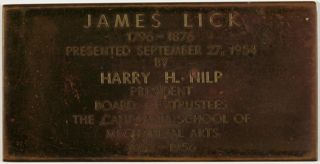From collection Member List

James Lick was born in a settler's cabin in Fredericksburg, Pennsylvania, on August 25, 1796. At an early age, he demonstrated the personal characteristics and vision that ultimately enabled him to become a multimillionaire. He possessed an iron will, worked hard, was keenly perceptive about business opportunities, and very shrewd when it came to taking the right risks at the right time.
In 1848, Lick landed at Yerba Buena, later called San Francisco. During the summer of 1848, gold was discovered on the Feather River. Although Lick did not make money in gold, he made a fortune off the Gold Rush. Many land owners had to acquire enough capital to go out and search for the precious metal so they began to sell their land dirt cheap. With an eye on how the city would eventually develop, James Lick invested $10,000 in Yerba Buena property. Within a year, it increased in value to $1 million and eventually reached a value of $3.5 million.
At the age of 77, Lick was ailing and put his affairs in order, arranging for the orderly disposal of his wealth. He did the unexpected for a man who had a reputation as a recluse with few friends, who had never become part of the San Francisco social scene. All of his wealth was to be converted into cash and most of that cash was to be donated to the betterment of the people in California. One such project was the establishment of a cash trust to endow the California School of Mechanical Arts (commonly referred to as "Lick"), "...the object and purpose of which shall be to educate males and females in the practical arts of life." The California School of Mechanical Arts opened in January 1895, offering free education to both boys and girls. The curriculum, both innovative and unique, combined general intellectual preparation with technical and vocational instruction.
Looking back on his long life, one understands why the San Francisco Chronicle wrote in March 1977, "He believed in this country, its arts, its science, its citizenry and its future."
In 1848, Lick landed at Yerba Buena, later called San Francisco. During the summer of 1848, gold was discovered on the Feather River. Although Lick did not make money in gold, he made a fortune off the Gold Rush. Many land owners had to acquire enough capital to go out and search for the precious metal so they began to sell their land dirt cheap. With an eye on how the city would eventually develop, James Lick invested $10,000 in Yerba Buena property. Within a year, it increased in value to $1 million and eventually reached a value of $3.5 million.
At the age of 77, Lick was ailing and put his affairs in order, arranging for the orderly disposal of his wealth. He did the unexpected for a man who had a reputation as a recluse with few friends, who had never become part of the San Francisco social scene. All of his wealth was to be converted into cash and most of that cash was to be donated to the betterment of the people in California. One such project was the establishment of a cash trust to endow the California School of Mechanical Arts (commonly referred to as "Lick"), "...the object and purpose of which shall be to educate males and females in the practical arts of life." The California School of Mechanical Arts opened in January 1895, offering free education to both boys and girls. The curriculum, both innovative and unique, combined general intellectual preparation with technical and vocational instruction.
Looking back on his long life, one understands why the San Francisco Chronicle wrote in March 1977, "He believed in this country, its arts, its science, its citizenry and its future."
Related Items

An Appeal to the Voters of California Booklet, 1900
This booklet describes the history, finances, and work of the school, making an argument for tax exemption status.
James Lick Born
James Lick is born in a settler's cabin in Fredericksburg, Pennsylvania.





